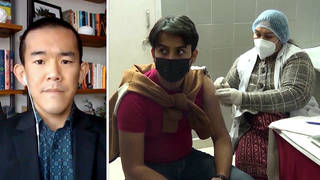
Related
Guests
- Sonia Shahinvestigative science journalist and the author of Pandemic: Tracking Contagions, from Cholera to Ebola and Beyond. Her new book is titled The Next Great Migration: The Beauty and Terror of Life on the Move and will be published in June. Her latest article, published in The Nation, is titled “Think Exotic Animals Are to Blame for the Coronavirus? Think Again.”
Sonia Shah is an investigative science journalist and author of “Pandemic: Tracking Contagions, from Cholera to Ebola and Beyond.” Her new book is titled “The Next Great Migration: The Beauty and Terror of Life on the Move” and will be published in June. She says the climate crisis is making outbreaks of infectious diseases more common, with the destruction of natural animal habitats and the changes in migration bringing humans and animals into ever-closer contact and making new pathogens more likely. Her latest article, published in The Nation, is titled “Think Exotic Animals Are to Blame for the Coronavirus? Think Again.”
Transcript
AMY GOODMAN: This is Democracy Now! I’m Amy Goodman, as we continue to look at the spread of the coronavirus, with cases now diagnosed in at least 47 countries and on every continent, save Antarctica. Nearly 3,000 people have died so far. The World Health Organization has declared the outbreak an international health emergency.
For more, we’re joined from Cleveland, Ohio, by Sonia Shah, science investigative journalist and the author of Pandemic: Tracking Contagions, from Cholera to Ebola and Beyond. Her new book is titled The Next Great Migration: The Beauty and Terror of Life on the Move. Her latest article, published in The Nation, “Think Exotic Animals Are to Blame for the Coronavirus? Think Again.”
Explain, Sonia Shah. And thanks so much for joining us.
SONIA SHAH: Thanks for having me. So, what I was trying to get at in that article was this fact that over the past 50 years we’ve had over 300 new pathogens either kind of newly emerge, that never have been seen before, or come into new places, where they’ve never been before. This novel coronavirus is just one of a whole spate of other pathogens we’ve seen — Ebola in West Africa, where it had never been seen before, Zika in the Americas, where it had never been seen before, new kinds of tick-borne diseases, new kinds of mosquito-borne diseases, new kinds of highly drug-resistant bacterial pathogens. And we know that about 60% of these new pathogens originate in the bodies of animals. About 70% of those are in wild animals. But it’s not because wild animals are particularly infested. It’s because of the way humans and wildlife are coming into novel intimate contact, and that is because of human activities.
AMY GOODMAN: So, talk about this connection between climate crisis and the coronavirus. We’re not hearing very much about this.
SONIA SHAH: Well, we know, in a general sense, that the climate crisis is resulting in tens of thousands of wild species moving into new places. It’s scrambling our migration patterns. And so that’s going to contribute to this broader phenomenon of people and wildlife coming into new kinds of contact. We can see with, for example, deforestation, that when you cut down the trees where bats roost, for example, they don’t just go away. They come and roost in your back gardens and your farms and your yards instead. And that allows people and bats to come into new kinds of contact. And the microbes that live in their bodies, which don’t cause them any kind of disease, can spill over into human bodies. And that’s how we turn animal microbes into these epidemic- and pandemic-causing pathogens.
AMY GOODMAN: So, how should this be dealt with? How should people understand the coronavirus? Diseases always exist, but how are epidemics and pandemics preventable?
SONIA SHAH: I mean, infectious disease is always going to exist. We live on a microbial planet, so that’s part of the human condition. We’re not going to get rid of all of the microbes, nor would we ever want to. But pandemics are something that we can do a lot to prevent. There’s a lot we can do to protect wildlife habitat, for example, so that the microbes in animals’ bodies stay in their bodies and don’t cross over into our bodies. We can do a lot to do active surveillance, to actually look for microbes that might be turning into human pathogens, and try to contain them before they start to cause epidemics. And that is scientific work that has been really successful the past 10 years. So if we have the political will to continue funding that kind of research, there is a lot that we can do to kind of reduce the risk of pandemics.
AMY GOODMAN: This is Congressmember Jan Schakowsky questioning Health and Human Services Secretary Alex Azar Wednesday about whether the coronavirus will be affordable to all.
REP. JAN SCHAKOWSKY: You’re saying it will for sure be affordable for anyone who needs it?
HHS SECRETARY ALEX AZAR: I’m saying we would — we would want to ensure that we work to make it affordable, but we can’t control that price, because we need the private sector to invest. The priority is to get vaccines and therapeutics. Price controls won’t get us there.
AMY GOODMAN: Schakowsky tweeted, following the hearing, she gave Azar three chances to assure us that any coronavirus vaccines or treatments developed with U.S. taxpayer dollars will be affordable and accessible to everyone, and he flat-out refused to do so. Sonia Shah?
SONIA SHAH: I mean, it’s just reprehensible. I think there’s a well-understood principle in the global health community that these are commodities that we need to make public. So, you know, this is like a real failure of leadership, and it’s actually — it’s a travesty.
AMY GOODMAN: Finally, what do you feel the corporate media, the mainstream media, is missing here, that you feel is essential for people to understand?
SONIA SHAH: I think there’s a sense in which we kind of frame narrative around disease outbreaks as something foreign, like an encroachment from outside that invades us, and kind of posits us as sort of these passive victims. But, actually — and I think that really obscures the larger story, which is that there’s a lot of human agency involved in how we’re turning microbes into pathogenic and pandemic-causing pathogens. So, I think we need to recast the whole way we talk about disease as not a problem of foreign invasion, you know, this — you know, we talk a lot about places when we talk about where diseases come from. We talk about the “Wuhan flu” or the “Spanish influenza,” even though that influenza did not originate in Spain. So, there’s a sense in which we want to try to make it seem like these are foreign things that are coming to get us and encroach upon us. And that’s a habit of mind that we have around a lot of other subjects, as well. But I think that obscures what our own role is. And there’s a lot we can do and that we are doing. We are turning a lot of these microbes into these pathogenic microbes instead.
AMY GOODMAN: And finally, with the Trump administration gutting the very government programs that were tasked to deal with something like this, the CDC cut 80% of its efforts to prevent global disease outbreaks because it was, quote, “running out of money.” The department went from working in 49 countries to just 10, with President Trump with his isolationist tendencies — you know, why give money to other countries? Explain why, Sonia Shah.
SONIA SHAH: Well, I think the — and the other program that’s been cut, that probably protected us from unknown pathogens, that we don’t know how much we’ve been protected, is the Predict program, which funded — was through the USAID and funded scientists to actually look for microbes that might be turning into pathogens. And over 10 years, they found about 900 different microbes that might be doing that, and were able to contain them at their source. And that’s the kind of program that the Trump administration also cut. And I think the reason they gave was that they were uncomfortable funding cutting-edge science.
AMY GOODMAN: Well, Sonia Shah, I want to thank you for being with us, science investigative journalist, author of Pandemic: Tracking Contagions, from Cholera to Ebola and Beyond. This is Democracy Now!, democracynow.org, The War and Peace Report. We will link to her piece in The Nation magazine that she just wrote, called “Think Exotic Animals Are to Blame for the Coronavirus? Think Again.”
When we come back, as Trump leaves India, the death toll from anti-Muslim violence in New Delhi has risen to at least 34. We’ll go to Delhi. Stay with us.












Media Options